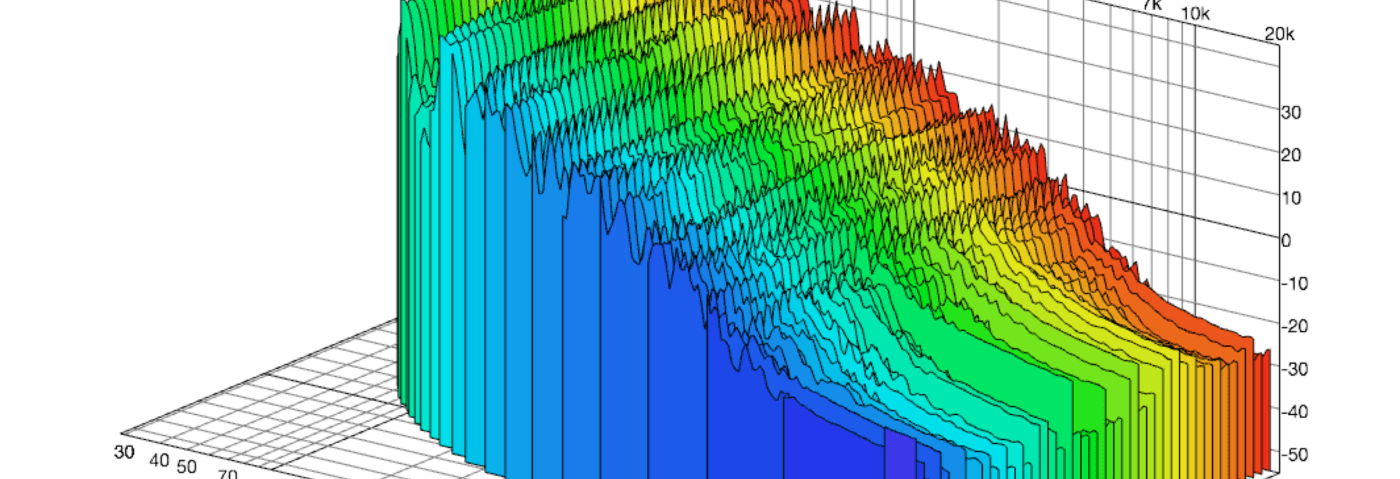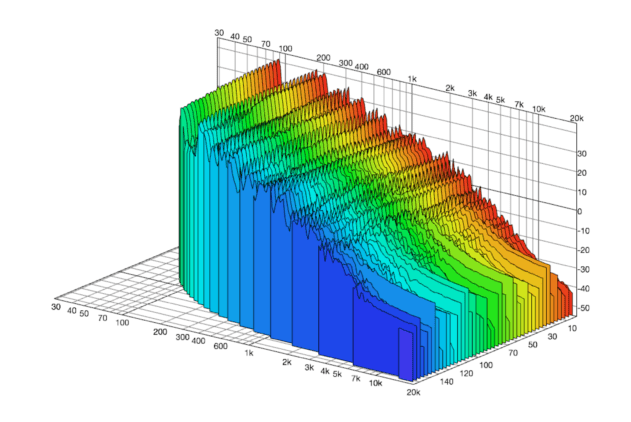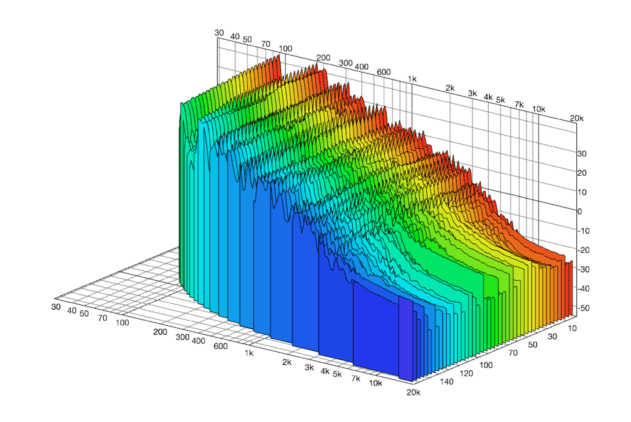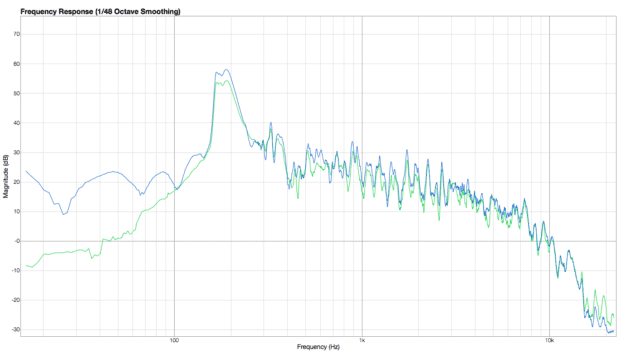Taking The Fall
Another way of comparing our different audio recording is by using a so-called waterfall display, which shows frequency changes over time as series of slices.
Here we’ve applied it to a brassy pad swell. Here’s the original pad recorded to digital:
And here’s the same pad cut to vinyl:
The graphs are smoothed to a 1/12 octave resolution, which makes it easier to get a handle on the overall timbral changes. We can clearly see the difference in response, particularly in the higher frequencies but also in an overall smoothing of the dynamic response around 200 Hz.
Desk Job
So far we’ve focused on analogue recording mediums, but it’s not all about vinyl or tape. It’s worth bearing in mind the impact of analogue signal chains in between other (digital) stages, such as a sampler and a DAW.
In this example we’ve got a tom drum hit originally recorded to digital, then bounced back out through an analogue desk before being recorded back to digital:
We can see a significant rolling off of frequencies below 100Hz, but above that point the curves are quite similar. There are differences throughout the frequency range (and a change in sound), but we’re not looking at the same kind of dramatic effect we might get from recording hot to tape.
Subtle flavouring is the key here.
In The Box
So how do we sum up the lesson we can learn from examining the effects of these various analogue processes? For most of The overwhelming majority of producers probably aren’t going to go to the effort and expense of pressing sounds to vinyl to capture the distinctive character of wax (although we’re not saying you should entirely rule out the option if you really want that sound). Likewise, most of us probably don’t have the luxury of expensive professional tape machines. But we can achieve similar sounds with a little common sense and some much cheaper tools…
Firstly, don’t be afraid to get heavy-handed with EQ in order to soften the tone of sounds. Sweeping cuts from 1 kHz upwards might seem at odds with clarity and definition, but analysis of the response curves of tape and vinyl clearly show a softening from a similar point. Not every element of a track has to be crisp and clear; drastic filtering can be effective in recreating some of the softer, mellower tones of analogue recordings.
Likewise, don’t be scared of noise. With digital synths and recording techniques we’re all accustomed to whisper-quiet noise floors, but the natural hiss of tape and even the subtle hum of some analogue circuits isn’t necessarily a bad thing; embracing a layer of low-level noise in your productions can add character.
Analogue hardware may tend to be relatively expensive compared to digital alternatives, but there are some great plugins out there that allow us to experiment in a broadly similar way. We particularly like U-he Satin for subtle tape effects, PSP’s ever-popular Vintage Warmer 2 for slightly more in-your-face saturation and D16’s Devastor for its powerful multi-band options.
Analogue recording is largely about flavour, and there are times when it can be pushed too far – just like the overuse of dynamic compression – but with a little examination of how these analogue processes affect signals, we can use similar effects to enhance our productions.




12.31 PM
Superbe Tipps!
I also Like the Studer A800 Plugin by UAD. I ll try this : Routing all Hi Hats to one Bus and insert the Studer Plugin =)
03.10 PM
Great article- I have been experimenting with Recording tracks to my Old TEAC Reel to Reel 1/2″ Tape . IMHO I’t’s a good halfway point between Cassete and a Pro Tape machine like a Studer. Probably cheaper to get a Plugin but decent old Reel to Reels can be had for little as 300.00 or les if you look hard.
02.27 AM
the bass a80 hot is played one octave below both other examples….
WHY?
10.00 AM
Same samples are also louder than others :/
02.07 PM
With this compendium, a good software developer could easily create the ultimate allround analogue plugin that contains all these characteristics in ONE PLUGIN – rather than having a seperate tape plugin, an analogue compressor plugin, a vintage preamp plugin etcetera
10.38 AM
Great article…
I’m not sure that the A80 Hot is an octave lower Johannes?
Also re: Paschalis comment – loudness will be altered by the saturation (and compression effect) of the processing – tape etc.
09.11 PM
That graph of ‘white noise’ looks more like Pink Noise since it’s a logarithmic scale and seems to show equal energy per octave. On a log scale, White noise will rise by 3dB per octave.
11.40 AM
If my analogue mixer had a response like the one on page 4, I’d throw it in the trash.
01.04 AM
being a virgin to audio on both forms of sound whether it be digital or analogue and on the cusp or transition to digital I’m definitely open to understanding both. I understand that sound is analogue to begin with but then needs to be recorded. Is it to my understanding that vinyl and tape are analogue. or are they turned to another format before made into tape or vinyl first. This is my quandary. if it is surely you’ll loose something from the recording or if this isn’t the case then analogue to analogue to analogue you lose nothing but add something like noise… etc